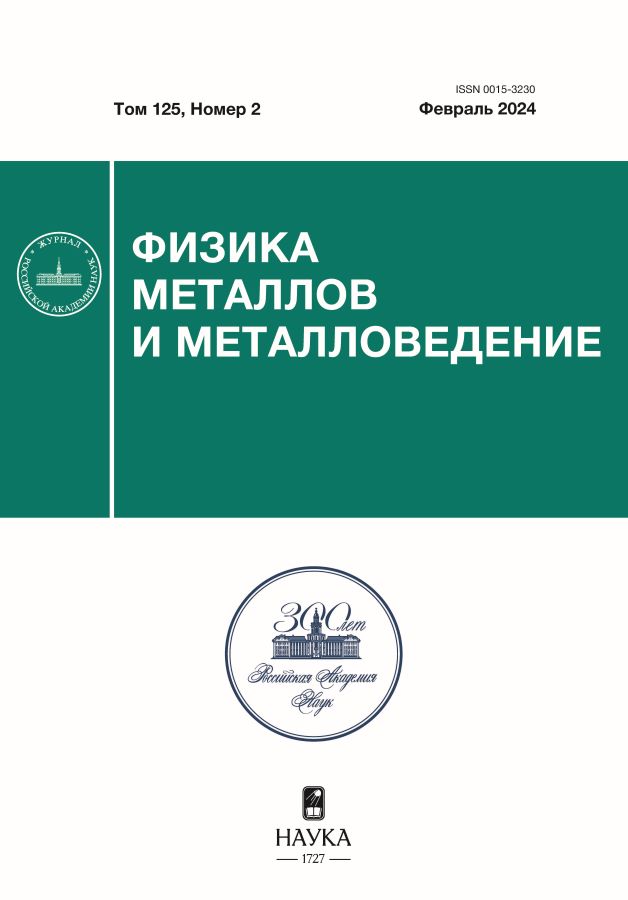Features of Phase Composition and Structure of Rapidly Quenched Ferromagnetic Mn–Al–Ga Alloy
- Authors: Fortuna A.S.1, Morozova T.A.1, Karpenkov D.Y.1, Gorshenkov M.V.1
-
Affiliations:
- National Research Technological University MISiS
- Issue: Vol 125, No 2 (2024)
- Pages: 214-220
- Section: СТРУКТУРА, ФАЗОВЫЕ ПРЕВРАЩЕНИЯ И ДИФФУЗИЯ
- URL: https://innoscience.ru/0015-3230/article/view/662844
- DOI: https://doi.org/10.31857/S0015323024020128
- EDN: https://elibrary.ru/YONXSS
- ID: 662844
Cite item
Abstract
Rapidly quenched Mn55Al36Ga9 ribbons were obtained by the spinning method. In the initial quenched state, the ribbons had a two-phase structure of the ε and γ2-phases. It has been established that, upon heating, the alloy undergoes a series of phase transformations, including the precipitation of the equilibrium β-Mn phase and its subsequent dissolution, the formation of the ferromagnetic τ-phase from both the ε and γ2-phases. The largest amount of the τ-phase was obtained by annealing at a temperature of 700 °C for 20 minutes. The work describes both the phase composition obtained as a result of annealing at different temperatures and the features of the microstructure studied by electron microscopy.
Full Text
About the authors
A. S. Fortuna
National Research Technological University MISiS
Author for correspondence.
Email: fortuna.as@misis.ru
Russian Federation, Moscow, 119049
T. A. Morozova
National Research Technological University MISiS
Email: fortuna.as@misis.ru
Russian Federation, Moscow, 119049
D. Yu. Karpenkov
National Research Technological University MISiS
Email: fortuna.as@misis.ru
Russian Federation, Moscow, 119049
M. V. Gorshenkov
National Research Technological University MISiS
Email: fortuna.as@misis.ru
Russian Federation, Moscow, 119049
References
- Kono H. On the Ferromagnetic Phase in Manganese-Aluminum System // J. Phys. Soc. Japan. 1958. V. 13. P. 1444–1451.
- Liu X.J., Ohnuma I., Kainuma R., Ishida K. Thermodynamic Assessment of the Aluminum-Manganese (Al-Mn) Binary Phase Diagram // J. Phase Equilibria. 1999. V. 20. P. 45–56.
- Кекало И.Б., Самарин Б.А. Физическое металловедение прецизионных сплавов. Сплавы с особыми магнитными свойствами. М.: Металлургия, 1989. 467 c.
- Park J.H., Hong Y.K., Bae S., Lee J.J., Jalli J., Abo G.S., Neveu N., Kim S.G., Choi C.J., Lee J.G. Saturation magnetization and crystalline anisotropy calculations for MnAl permanent magnet // J. Appl. Phys. 2010. V. 107. 09A731. P. 1–3.
- Fang H., Kontos S., Ångstrom J., Cedervall J., Svedlindh P., Gunnarsson K., Sahlberg M. Directly obtained τ-phase MnAl, a high performance magnetic material for permanent magnets // J. Solid State Chem. 2016. V. 237. P. 300–306.
- Feng L., Freudenberger J., Mix T., Nialsch K., Woodcock T.G. Rare-earth-free MnAl–C–Ni permanent magnets produced by extrusion of powder milled from bulk // Acta Mater. 2020. V. 199. P. 155–168.
- Pareti L., Bolzoni F., Leccabue F., Ermakov A.E. Magnetic anisotropy of MnAl and MnAlC permanent magnet materials // J. Appl. Phys. 1986. V. 59. P. 3824–3828.
- Zhao S., Wu Y., Zhang C., Wang J., Fu Z., Zhang R., Jiang C. Stabilization of t-phase in carbon-doped MnAl magnetic alloys // J. Alloys Compounds. 2018. V. 755. P. 257–264.
- Sakka Y., Nakamura M., Hoshimoto K. Rapid quenching and properties of hard magnetic materials in MnAI–X (X = Ti, Cu, Ni, C, B) systems // J. Mater. Sci. 1989. V. 24. P. 4331–4338.
- Mix T., Bittner F., Müller K.-H. Schultz L., Woodcock T.G. Alloying with a few atomic percent of Ga makes MnAl thermodynamically stable // Acta Mater. 2017. V. 128. P. 160–165.
- Mix T., Woodcock T.G. Advanced thermal stability investigations of the Mn–Al–Ga system // Results Mater. 2020. V. 5. 100068. P. 1–4.
- Xiang Z., Deng B., Xiang Z., Wang X., Cui E., Yu L., Song Y., Lu W. Nanocrystalline MnAlV rare-earth-free Permanent Magnetic Alloys with Improved Magnetization and Thermal Stability // Intermetallics. 2020. V. 116. 106638. P. 1–6.
- Xiang Z., Song Y., Deng B., Cui E., Yu L., Lu W. Enhanced formation and improved thermal stability of ferromagnetic τ phase in nanocrystalline Mn55Al45 alloys by Co addition // J. Alloys and Compounds. 2019. V. 783. P. 416–422.
- Шелехов Е.В., Свиридова Т.А. Программы для рентгеновского анализа поликристаллов // МиТОМ. 2000. 8. C. 16–19.
- Wiezorek J.M.K., Kulovits A.K., Yanar C., Soffa W.A. Grain Boundary Mediated Displacive–Diffusional Formation of s-Phase MnAl // Metal. Mater. Trans. A. 2011. V. 42A. P. 594–604.
- Jia Y., Ding H., Wu Y., Wang J., Wu H., Ma T., Zhao S., Skokov K.P., Aubert A., Maccari F., Gutfleisch O., Xu Y., Niu J., Qiao B., Zhao S., Jiang C. On the ε → τ phase transformation and twinning in L10–MnAl alloys // Acta Mater. 2022. V. 232. 117892. P. 1–17.
- Bittner F., Schultz L., Woodcock T.G. The role of the interface distribution in the decomposition of metastable L10–Mn54Al46 // J. Alloys Compounds. 2017. V. 727. P. 1095–1099.
- Palanisamy D., Raabe D., Gault B. On the compositional partitioning during phase transformation in a binary ferromagnetic MnAl alloy // Acta Mater. 2019. V. 174. P. 227–236.
Supplementary files

















